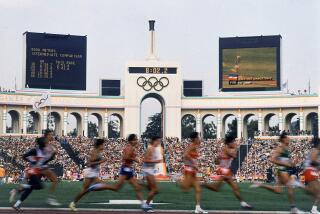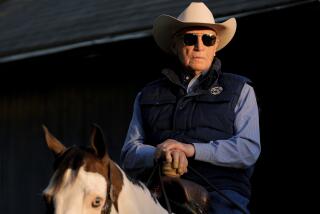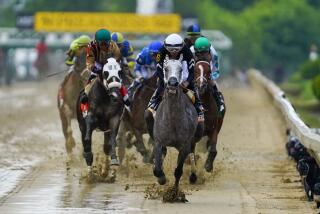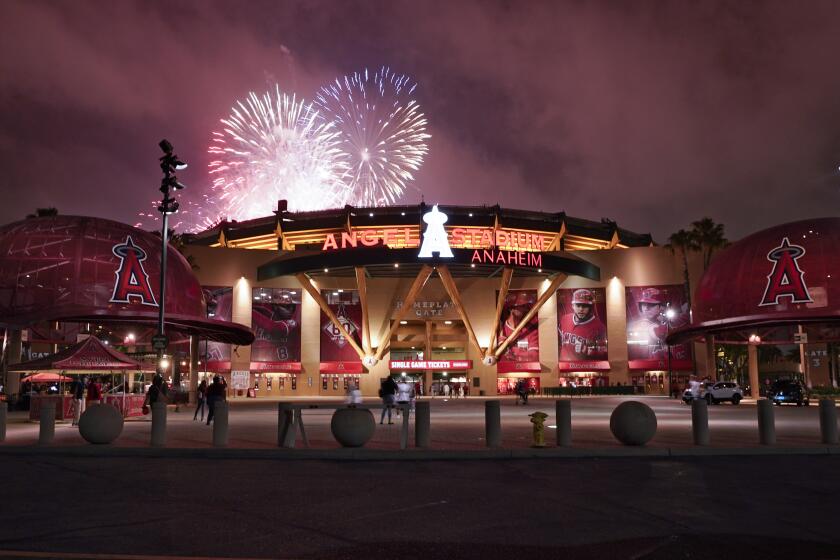GOING TO EXTREMES : Careening Toward Legitimacy : Pioneering Pereyra Brings Street Luge Racing Out of the Shadows
- Share via
NORTHRIDGE — Flat on his back and heading straight downhill within an inch of his life, Bob Pereyra finds himself on a collision course with notoriety he only fantasized about all those years zipping over the scorched asphalt of Mulholland Highway.
Too late to brake now.
Street luge racing, the motorless and, some would say, mindless obsession Pereyra pioneered and tirelessly promotes, is among the featured sports at the ESPN Extreme Games, to be held Saturday through July 1 in Rhode Island.
This is a triumphant yet turbulent time for the 32-year-old part-time auto detailer who still lives in the Northridge home where he grew up. The organization he founded, Road Racers Assn. for International Luge (RAIL), is finally being recognized as something other than a loose collection of low-life lugers.
Actually, pilots is the preferred term. But by any name, the deluge of attention has Pereyra a bit disoriented.
“Everything I have goes directly into this sport,” Pereyra said. “It’s kind of unsettling that all of a sudden there is so much interest, and I hope that all this exposure makes it legitimate.”
Two street luge events will be included in the Extreme Games: dual luge, which pits one pilot against another, and mass luge, in which four pilots race. The dual luge final is scheduled to be televised live on ESPN June 26 from 7:30-10:30 p.m. and the mass luge preliminaries and final are scheduled to be televised live June 28 from 5-6:30 p.m.
The 32 pilots in the games all are members of RAIL and include 24 from the United States, six from Germany and two from Italy.
Pereyra would be the odds-on favorite were he not injured. He fractured his left heel in a crash June 4 during a practice run over the Extreme Games course in Providence, R.I. The network was experimenting with camera positioning and Pereyra slid off the road and into a curb.
“It was a foolish thing to happen this late in the ballgame,” Pereyra said. “I failed to negotiate the very first corner. I was unfamiliar with the pavement in Providence and my wheels didn’t stick.
“I had to decide between turning and hitting a tree broadside or just flying into the curb.”
Decisions, decisions. They must be instantaneous while lying on a flying luge an inch above the ground. Pereyra gave a only tad more thought to deciding whether he will compete in the Extreme Games.
“I’m there,” he said confidently after taking a few practice runs down a long street in an undeveloped area of Porter Ranch. Nevertheless, two concerns remain: fitting his swollen ankle into his snazzy protective leather suit, and being able to stop at high speeds.
Pilots brake simply by putting their thick-soled shoes on the ground. Smoke flies and rubber burns, emitting an acrid odor. An injured heel is the equivalent of a car with a damaged brake rotor.
“We’d love to have Bob in top shape but we think he’ll compete,” said Chris Stiepock, an ESPN spokesman. “Bob has a history of injuries. He’s luged with all sorts of pains.”
Broken bones and road burns ride shotgun on a luge. Pereyra likes to say, “I’ve already broken my bones to make the sport safe for you,” and lately the RAIL line has been that street luge can be made safe and sane.
“We are slowly changing the image from this being an underground, renegade sport to one of safety, integrity and credibility,” said Judy Yu, a member of the RAIL management advisory board.
Yet pain played a part even in the sport’s origin. Pereyra raced motorcycles until his brother, Eddie, died on one in a crash on Mulholland Highway in 1984.
Shaken, Pereyra scaled back his own thrills on wheels, limiting himself to skateboards. He stood on them, sat on them, then in a moment of inspiration, laid on his back and whisked down Mulholland.
“It seems like I’ve spent every day since Eddie died up on Mulholland doing this,” he said.
The sport evolved through equal parts inventiveness and recklessness. Skateboards gave way to longer pieces of wood and the wood gave way to an aluminum chassis three inches wide.
Handrails, foot pedals and a headrest were added. Today, rail sleds, as luges are also called, are eight feet long and roll on four poured urethane wheels. Racing stickers and logos of sponsors adorn the sleek sleds, giving them unmistakable macho appeal.
Reducing wind resistance is key to gaining optimum speed, and the best pilots are built like Pereyra, who at 6-1, 150 pounds, resembles his organization’s acronym.
Racing gear evolved as well. Pereyra and his handful of luger friends tried various rubber compounds to bolster the soles of shoes-cum-brakes. Apparel now includes a full-face helmet, leathers, gloves and high-top shoes.
No amount of safety gear and image building can make street luge a middle-of-the-road endeavor. The high point so far for RAIL’s 67 members was a race at Laguna Seca Raceway last July that was part of the Monterey Sports Car Grand Prix.
Other RAIL-sanctioned events have been held in obscurity, on lonely mountain roads and undeveloped suburban streets. The longest--12 miles--and fastest--82 m.p.h.--was held last year at Mt. Rainier in Washington.
Pereyra hopes the exposure on Extreme Games vaults the sport into prominence.
“This competition is so important because it could fuel other competitions on a regional basis internationally,” he said. “It is difficult to standardize courses, but we are trying to come up with a method of developing points standings.”
Getting street luge accepted as an exhibition sport in the Olympics is a long-range goal, but building RAIL’s ranks comes first.
Pereyra runs the organization out of his house with his girlfriend, Rachel Wooster, and his father, Hugo.
The office work is necessary but the reward comes when Pereyra and his pals load up their luges and drive to the top of a street with nowhere to go but down.
“I’ve created a sled and manipulated it to go this speed,” he said. “You get so in tune with what you are doing, it is the calmest thing on earth. It is very, very peaceful.
“Then at the end of the run, we look around and take a head count, and if everyone is OK, then there is the rush.”
More to Read
Go beyond the scoreboard
Get the latest on L.A.'s teams in the daily Sports Report newsletter.
You may occasionally receive promotional content from the Los Angeles Times.











